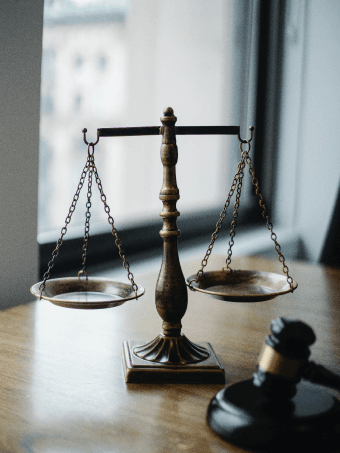As a trademark law firm, we've reviewed plenty of "parody" trademark submissions over the years. Some of these puns and playful twists on older brands and their taglines were definitely clever, but very few ever make it through to registration. Truthfully, parody trademarks live in a tricky gray area where creativity and trademark law often clash. There are examples, such as FEYONCÉ BAE-Z or Lord of the Fries, where witty, attention-grabbing wordplays can become successfully registered trademarks. However, for every one of these that gets approved, dozens (if not hundreds) more are rejected for lacking distinctiveness or for being too similar to an existing brand. Many entrepreneurs misunderstand the legal line when it comes to parodies and assume that if something is a joke, it automatically qualifies as fair use. Oftentimes, this couldn't be farther from the truth.
Why parody trademarks are so complicated
The idea behind a parody is to comment on or poke fun at an existing brand, not necessarily to compete with it. Accordingly, parody marks walk a fine line between humor and infringement. What crosses that line is when a parody becomes a brand in itself, i.e., a joke used to sell or promote products. This can quickly turn the joke into a legal problem.
Courts generally focus on one central issue in these cases: consumer confusion. This means that if the average consumer might think your parody product is made, endorsed, or affiliated with the original brand, you're likely to encounter problems. This is where many clever ideas fall apart and lose their protection under 'free speech'.
When “just a joke” turns into a legal battle
To illustrate how risky parody trademarks can be, let's take a look at a couple of famous examples:
Chewy Vuiton was a line of dog toys designed to parody Louis Vuitton. The products mimicked the luxury brand’s famous logos and handbag shapes but with a canine twist. Louis Vuitton sued for trademark dilution, arguing that the parody tarnished its brand. Surprisingly, Chewy Vuiton won. The court ruled that consumers were unlikely to confuse a squeaky dog toy with a designer handbag. The company continues to sell its products today, but that victory came after years of expensive litigation. So, even when you win, parodies can cost you a lot of time, money, and resources.
On the other hand, there’s The South Butt, a satirical take on The North Face. The company sold apparel featuring a logo similar to that of the outdoor giant. While the parody was obvious, The North Face didn’t find it funny. After a lengthy legal exchange, The South Butt ended up settling and agreeing to stop using the mark entirely. The takeaway was: the bigger the brand, the higher the likelihood that humor might be misinterpreted as brand theft.
The Supreme Court weighs in
More recently, the U.S. Supreme Court tackled the issue in Jack Daniel’s v. VIP Products (2023). VIP Products made a dog toy called “Bad Spaniels” that copied Jack Daniel’s iconic bottle design and label, swapping out the whiskey’s details for canine jokes. The company argued it was a parody protected under the First Amendment.
The Supreme Court disagreed. It ruled that if a parody also functions as a trademark (i.e., it identifies the source of the parody product), then free speech doesn’t shield it. Humor alone doesn’t make a product immune to trademark laws. If it risks confusing consumers or diluting a brand’s identity, then infringement is still infringement.
Are all parodies at risk, then?
Not at all. Parodies are far safer when used for commentary, art, or social criticism, rather than for commercial products. Political cartoons, online memes, and artistic endeavors often qualify as protected speech. But once you attach that parody to a product, brand, or marketing campaign, it crosses into the commercial realm, and the law becomes much stricter.
Trademarks exist to help consumers identify the origin of a product. So, unfortunately, if your parody could make someone believe it’s officially associated with the brand you’re mocking, it goes against the very purpose of trademark protection. Courts care less about whether your parody is clever or well-intentioned and more about whether it misleads.
Striking the right balance
So, if you’re brainstorming a brand that parodies something famous, ask yourself a simple question before filing: Would consumers think this is affiliated with the original brand?
If there’s even a slight chance, reconsider using it commercially. A parody might win you laughs on social media, but it can also invite a slew of legal issues down the line.
Parodies and branding can coexist, but only when you understand the limits. Before you try to turn your clever idea into a commercial product, make sure your punchline doesn’t come with legal strings attached. At the end of the day, a joke is meant to make people laugh; it shouldn’t make your lawyer sweat.
FAQ: Understanding Parody Trademarks
1. Why are parody trademarks so difficult to register?
Because they usually reference existing brands, parody trademarks risk being seen as confusingly similar or non-distinctive. Trademark law prioritizes consumer clarity. So, if your parody could make people think it’s connected to the original brand, it’s unlikely to pass. Humor doesn’t override that legal standard.
2. Can parody ever be protected under free speech?
Yes, but only in non-commercial contexts. Artistic expressions, memes, and social commentary are generally protected as free speech. However, once the parody becomes a brand (i.e., it's used to market or sell products), it’s treated like any other trademark and must comply with the same rules against confusion and dilution.
3. What’s the safest way to use parody in branding?
If your idea directly mimics or references a well-known company, tread carefully. Avoid visual or verbal similarities that could imply affiliation. The safest route is to focus on originality, and take inspiration from humor, not from another brand’s identity. When in doubt, consult a trademark professional before filing.


